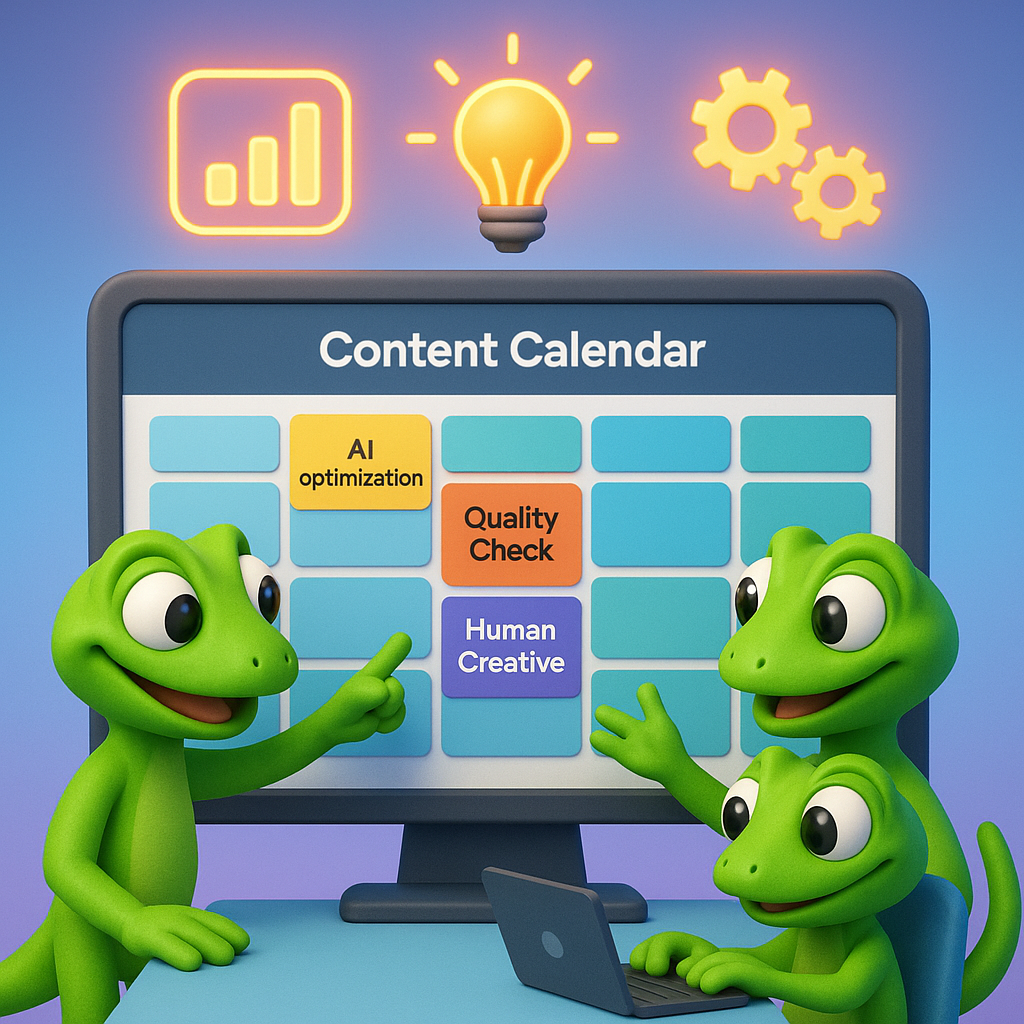Integrating LLMo Insights Into Content Calendars for Marketing Leaders
In the age of AI-driven search, your content calendar isn’t just a publishing schedule—it’s a strategic asset that can make or break your visibility across traditional and generative AI platforms. Large Language Models (LLMs) are fundamentally reshaping how users discover content, with 58% of consumers now using generative AI for recommendations, up from just 25% in 2023. This shift demands a complete rethinking of how marketing leaders approach content planning and execution.

Transforming Content Calendars with LLM Intelligence
Traditional content calendars focus primarily on publishing cadence and channel distribution. LLM-enhanced calendars incorporate AI-driven insights across the entire content lifecycle:
1. Strategic Planning & Topic Selection
LLMs now identify high-opportunity content clusters through automated keyword analysis that’s transforming how marketers prioritize content:
-
AI-Powered Topic Clustering: Free keyword clustering tools process thousands of keywords in minutes (vs. days of manual work), organizing them into strategic groups that prevent cannibalization and target related search intents. Companies using LLM-driven clustering report 28% more traffic by prioritizing high-performing themes.
-
Multi-Channel Intent Mapping: Modern content calendars must layer strategies for SEO (traditional search), AEO (answer engines), and GEO (generative AI citations). This three-pronged approach ensures content remains discoverable regardless of how users search. As one marketing director noted: “The ROI was undeniable after just one month of implementing AI-driven content planning.”
-
Competitive Gap Analysis: LLMs process diverse data sources to identify gaps in competitors’ content strategies, enabling teams to spot untapped opportunities. For example, one fintech company discovered an entire content cluster around “investment automation” that competitors had overlooked, leading to a dominant position in that niche.
2. Content Brief Generation & Research
LLMs streamline the critical research phase in your content calendar workflow:
-
Data-Backed Briefs: AI analyzes top-ranking content to inform subtopic coverage and structural optimization, ensuring your calendar includes all essential elements for comprehensive coverage. These briefs become the foundation of your calendar, detailing not just what to publish but exactly how to structure it for maximum impact.
-
E-A-T Alignment: Calendar entries now include E-A-T (Expertise, Authority, Trustworthiness) requirements to satisfy both traditional search and AI citation standards. For instance, scheduling regular updates to cornerstone content maintains freshness signals that influence both ranking and LLM citation frequency.
-
Research Enhancement: Rather than starting from scratch, content teams use LLMs to analyze existing high-performing content, identifying patterns in structure, depth, and presentation that correlate with success. This research-driven approach reduces the guesswork in content planning.
3. Production Acceleration & Quality Enhancement
LLM-enhanced calendars dramatically improve content production velocity:

-
Production Efficiency: One SaaS company reduced blog creation time from 8 hours to 2 hours with AI-assisted workflows while maintaining quality standards. Their calendar now accounts for this increased velocity, allowing for more ambitious publication schedules.
-
Scaling Output: A financial services firm increased monthly content from 5 to 50 pieces without expanding staff using AI content generation tools. Their calendar shifted from monthly to weekly planning cycles to accommodate this dramatic increase in output.
-
Quality Control: Advanced LLM applications include scheduled fact-checking and citations to maintain accuracy while scaling content production. This creates dedicated calendar slots for quality reviews, preventing rushed publication of unchecked material.
4. Performance Monitoring & Optimization
The most sophisticated content calendars now incorporate real-time performance data:
-
Traditional + AI Metrics: Effective calendars track both traditional metrics (rankings, traffic) and emerging LLM metrics (AI citations, LLM visibility) using specialized tools for monitoring LLMO performance.
-
Automated Optimization Alerts: AI detection of content cannibalization and performance issues enables calendar adjustments based on actual results. For example, when two pieces compete for the same keyword, the calendar automatically flags the conflict and suggests consolidation or differentiation.
-
Traffic Impact Tracking: Viralsweep eliminated keyword cannibalization through LLM-driven calendaring, gaining 2,172+ monthly clicks and top-10 rankings. Their calendar now includes monthly content audits specifically focused on preventing competitive overlap.
Implementing LLM-Enhanced Content Calendars: A Framework
Phase 1: Calendar Structure Transformation
-
Layered Content Architecture: Structure your calendar to address traditional SEO, answer engine optimization, and generative AI citation opportunities simultaneously. For each topic, plan content elements designed specifically for each channel rather than one-size-fits-all content.
-
Content Workflow Integration: Establish defined states for content progression (briefed → researched → drafted → edited → illustrated → reviewed → shared → published) to maintain visibility across your calendar. This workflow-based approach prevents bottlenecks and provides clear status indicators.
-
Journey Mapping: Align calendar entries with customer journey stages using LLM optimization techniques to ensure content matches intent at each funnel stage. For example, schedule awareness content earlier in the quarter, followed by consideration and decision content as leads progress.
Phase 2: AI-Powered Decision Making
-
Sentiment-Driven Scheduling: Use LLMs to analyze audience sentiment across channels, timing content releases for maximum engagement. One retail brand discovered their technical content performed 35% better when published mid-week, while inspirational content thrived on Mondays.
-
Performance-Based Prioritization: Leverage real-time data to adjust calendar priorities based on actual performance rather than assumptions. Create a “flexible 20%” in your calendar that can be reallocated to high-performing topics or formats based on emerging data.
-
Competitive Intelligence: Schedule content to counter competitor strengths and exploit identified gaps in their content strategy. Set calendar alerts for monitoring competitor publishing patterns and build responsive content blocks that can quickly address emerging threats.
Phase 3: Measurement & Refinement
-
Dual-Metric Tracking: Monitor both traditional SEO metrics and LLM visibility indicators to gauge calendar effectiveness. Create dashboard views that compare traditional search performance against AI citation rates.
-
ROI Calculation: Implement structured ROI tracking to quantify calendar impact on business goals. For example, use an SEO ROI calculator to measure the financial impact of your content strategy.
-
Continuous Optimization: Use performance data to refine future calendar entries, creating a feedback loop that improves results over time. Schedule quarterly calendar reviews where historical performance informs future planning.
Real-World Success: Case Studies in LLM-Enhanced Content Calendars
-
Promoty’s Traffic Explosion: Achieved a 224% monthly traffic increase by implementing AI-driven SEO calendar strategies that aligned content with both traditional and LLM search patterns. Their calendar now includes a dedicated “AI optimization” phase for each content piece.
-
E-Commerce Conversion Boost: Retail brands leveraging LLM-enhanced calendars saw 45% increase in organic traffic and 38% conversion rate improvement by aligning content with AI discovery patterns. One clothing retailer restructured their entire calendar around seasonal search intent patterns identified by LLMs.
-
Efficiency Revolution: Marketing teams using AI-enhanced calendars save ~12.5 hours weekly (25 days annually) through streamlined planning and execution. A B2B technology firm reallocated this time to strategy and creative ideation, resulting in more innovative content formats.
Avoiding Common Pitfalls
While integrating LLM insights into content calendars delivers substantial benefits, be aware of these challenges:
-
Overreliance on AI: Content strategists warn that “Over-reliance on LLMs risks generic content and loss of brand voice.” The most effective calendars use AI to augment human creativity, not replace it. Reserve calendar slots for purely creative, human-driven content alongside AI-optimized pieces.
-
Quality Control: Implement systematic review stages in your calendar to ensure AI-influenced content maintains factual accuracy and brand standards. One healthcare company schedules mandatory expert reviews for all AI-assisted content to maintain medical accuracy.
-
Attribution Challenges: As LLM search grows, tracking attribution becomes more complex. Build multi-touch attribution models into your calendar performance metrics. This might include tracking direct citation rates in AI platforms alongside traditional traffic metrics.
Future-Proofing Your Content Calendar Strategy
As search evolves, your content calendar strategy must adapt. Key developments to incorporate:
-
Multimodal Integration: Calendar entries should now include plans for visual, text, and potentially video content to support multimodal AI search capabilities. Schedule different formats for the same core topics to maximize discovery potential.
-
Enhanced Schema Planning: Schedule regular reviews of schema markup implementation to ensure content remains interpretable by both traditional search and LLMs. Dedicate calendar slots specifically to technical optimization of existing content.
-
Traditional/AI Content Balance: Comparing traditional SEO vs LLMO techniques reveals the need for strategic balance in your calendar between optimization approaches. Aim for a 70/30 split between evergreen, comprehensive content and focused, answer-oriented content optimized for AI extraction.
TL;DR
Integrating LLM insights into content calendars transforms them from simple publishing schedules into strategic assets that drive measurable ROI. By structuring calendars to incorporate AI-driven topic selection, intent-based planning, accelerated production, and real-time performance data, marketing leaders can achieve significant efficiency gains (saving 12.5 hours weekly) while dramatically improving content performance (up to 224% traffic growth). The most effective implementation combines traditional SEO fundamentals with emerging LLM optimization techniques to create a future-proof content strategy that performs well across all search environments.
